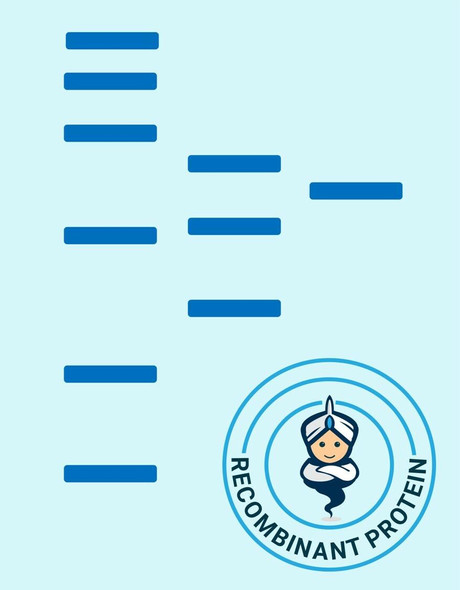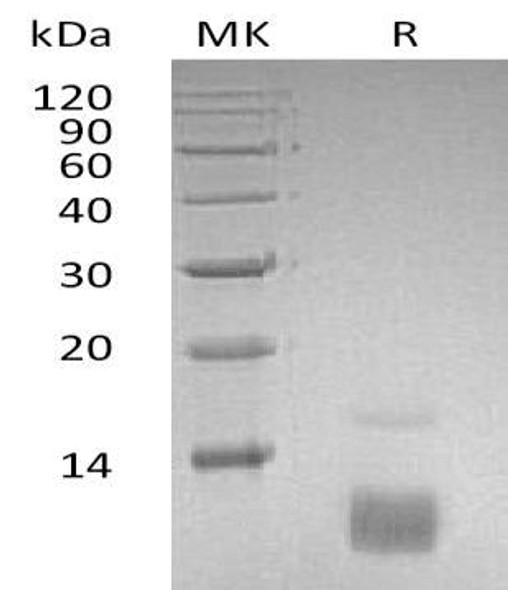Chemokines Recombinant Proteins
Human Rantes Recombinant Protein (RPPB1241)
- SKU:
- RPPB1241
- Product Type:
- Recombinant Protein
- Species:
- Human
- Uniprot:
- P13501
- Research Area:
- Chemokines
Description
| Product Name: | Human Rantes Recombinant Protein |
| Product Code: | RPPB1241 |
| Size: | 20µg |
| Species: | Human |
| Target: | Rantes |
| Synonyms: | Small inducible cytokine A5, CCL5, T-cell-specific RANTES protein, SIS-delta, T cell- specific protein P228, TCP228, chemokine (C-C motif) ligand 5, SISd, SCYA5, RANTES, D17S136E, MGC17164. |
| Source: | Escherichia Coli |
| Physical Appearance: | Sterile Filtered White lyophilized (freeze-dried) powder. |
| Formulation: | Lyophilized from a 0.2�m filtered concentrated solution in 50mM NaAc, pH 5.0, 100mM NaCl. |
| Solubility: | It is recommended to reconstitute the lyophilized Rantes in sterile 18M?-cm H2O not less than 100�g/ml, which can then be further diluted to other aqueous solutions. |
| Stability: | Lyophilized Rantes although stable at room temperature for 3 weeks, should be stored desiccated below -18°C. Upon reconstitution Rantes should be stored at 4°C between 2-7 days and for future use below -18°C. For long term storage it is recommended to add a carrier protein (0.1% HSA or BSA).Please prevent freeze-thaw cycles. |
| Purity: | Greater than 97.0% as determined by:(a) Analysis by RP-HPLC.(b) Analysis by SDS-PAGE. |
| Amino Acid Sequence: | SPYSSDTTPC CFAYIARPLP RAHIKEYFYT SGKCSNPAVV FVTRKNRQVC ANPEKKWVRE YINSLEMS |
| Biological Activity: | The Rantes�activity is determined by the chemoattract of human blood monocytes at a concentration between 1-10ng/ml corresponding to a Specific Activity of 100,000-1,000,000IU/mg. |
Regulated upon Activation, Normal T-cell Expressed, and Secreted or RANTES is an 8 kDa protein classified as a chemotactic cytokine or chemokine. Rantes has recently been renamed CCL5. RANTES is chemotactic for T cells, eosinophils and basophils and plays an active role in recruiting leukocytes into inflammatory sites. With the help of particular cytokines (i.e. IL-2 and IFN-g) that are released by T cells, RANTES also induces the proliferation and activation of certain natural killer (NK) cells to form CHAK (CC-Chemokine-activated killer) cells. Rantes is also an HIV-suppressive factor released from CD8+ T cells. The Rantes�chemokine has been localized to chromosome 17 in humans.
Rantes Human Recombinant produced in E.Coli is a single, non-glycosylated polypeptide chain containing 68 amino acids and having a molecular mass of 7809.2 Dalton. The Rantes is purified by proprietary chromatographic techniques.
| UniProt Protein Function: | CCL5: Chemoattractant for blood monocytes, memory T-helper cells and eosinophils. Causes the release of histamine from basophils and activates eosinophils. Binds to CCR1, CCR3, CCR4 and CCR5. One of the major HIV-suppressive factors produced by CD8+ T- cells. Recombinant RANTES protein induces a dose-dependent inhibition of different strains of HIV-1, HIV-2, and simian immunodeficiency virus (SIV). The processed form RANTES(3-68) acts as a natural chemotaxis inhibitor and is a more potent inhibitor of HIV-1-infection. The second processed form RANTES(4-68) exhibits reduced chemotactic and HIV-suppressive activity compared with RANTES(1-68) and RANTES(3-68) and is generated by an unidentified enzyme associated with monocytes and neutrophils. By mitogens. T-cell and macrophage specific. Belongs to the intercrine beta (chemokine CC) family. |
| UniProt Protein Details: | Protein type:Chemokine; Secreted; Cell adhesion; Motility/polarity/chemotaxis; Secreted, signal peptide Chromosomal Location of Human Ortholog: 17q12 Cellular Component: extracellular space; cytoplasm; extracellular region Molecular Function:protein homodimerization activity; protein self-association; receptor signaling protein tyrosine kinase activator activity; phosphoinositide phospholipase C activity; protein kinase activity; protein binding; CCR1 chemokine receptor binding; CCR4 chemokine receptor binding; chemokine receptor binding; chemokine activity; chemokine receptor antagonist activity; phospholipase activator activity; CCR5 chemokine receptor binding; chemoattractant activity Biological Process: regulation of chronic inflammatory response; exocytosis; positive regulation of cell adhesion; response to toxin; positive regulation of smooth muscle cell proliferation; positive regulation of JAK-STAT cascade; positive regulation of smooth muscle cell migration; chemotaxis; positive regulation of cell-cell adhesion mediated by integrin; protein amino acid phosphorylation; positive regulation of homotypic cell-cell adhesion; positive regulation of translational initiation; monocyte chemotaxis; leukocyte adhesion; cell-cell signaling; positive chemotaxis; calcium ion transport; positive regulation of innate immune response; protein kinase B signaling cascade; lipopolysaccharide-mediated signaling pathway; dendritic cell chemotaxis; positive regulation of T cell proliferation; inflammatory response; protein tetramerization; phospholipase D activation; positive regulation of viral genome replication; neutrophil activation; negative regulation of G-protein coupled receptor protein signaling pathway; response to virus; MAPKKK cascade; positive regulation of cellular biosynthetic process; macrophage chemotaxis; cellular calcium ion homeostasis; positive regulation of phosphoinositide 3-kinase cascade; G-protein coupled receptor protein signaling pathway; cellular protein complex assembly; positive regulation of tyrosine phosphorylation of STAT protein; negative regulation of viral genome replication; eosinophil chemotaxis; positive regulation of calcium ion transport; regulation of insulin secretion; positive regulation of epithelial cell proliferation; positive regulation of phosphorylation; positive regulation of cell migration; regulation of T cell activation |
| NCBI Summary: | This gene is one of several chemokine genes clustered on the q-arm of chromosome 17. Chemokines form a superfamily of secreted proteins involved in immunoregulatory and inflammatory processes. The superfamily is divided into four subfamilies based on the arrangement of the N-terminal cysteine residues of the mature peptide. This chemokine, a member of the CC subfamily, functions as a chemoattractant for blood monocytes, memory T helper cells and eosinophils. It causes the release of histamine from basophils and activates eosinophils. This cytokine is one of the major HIV-suppressive factors produced by CD8+ cells. It functions as one of the natural ligands for the chemokine receptor chemokine (C-C motif) receptor 5 (CCR5), and it suppresses in vitro replication of the R5 strains of HIV-1, which use CCR5 as a coreceptor. Alternative splicing results in multiple transcript variants that encode different isoforms. [provided by RefSeq, Jul 2013] |
| UniProt Code: | P13501 |
| NCBI GenInfo Identifier: | 6175077 |
| NCBI Gene ID: | 6352 |
| NCBI Accession: | P13501.3 |
| UniProt Secondary Accession: | P13501,O43646, Q0QVW8, Q4ZGJ1, Q9NYA2, Q9UBG2, Q9UC99 |
| UniProt Related Accession: | P13501 |
| Molecular Weight: | 91 |
| NCBI Full Name: | C-C motif chemokine 5 |
| NCBI Synonym Full Names: | chemokine (C-C motif) ligand 5 |
| NCBI Official Symbol: | CCL5�� |
| NCBI Official Synonym Symbols: | SISd; eoCP; SCYA5; RANTES; TCP228; D17S136E; SIS-delta�� |
| NCBI Protein Information: | C-C motif chemokine 5; beta-chemokine RANTES; T-cell specific protein p288; eosinophil chemotactic cytokine; small inducible cytokine subfamily A (Cys-Cys), member 5; regulated upon activation, normally T-expressed, and presumably secreted |
| UniProt Protein Name: | C-C motif chemokine 5 |
| UniProt Synonym Protein Names: | EoCP; Eosinophil chemotactic cytokine; SIS-delta; Small-inducible cytokine A5; T cell-specific protein P228; TCP228; T-cell-specific protein RANTESCleaved into the following 2 chains:RANTES(3-68); RANTES(4-68) |
| Protein Family: | C-C motif chemokine |
| UniProt Gene Name: | CCL5�� |
| UniProt Entry Name: | CCL5_HUMAN |






